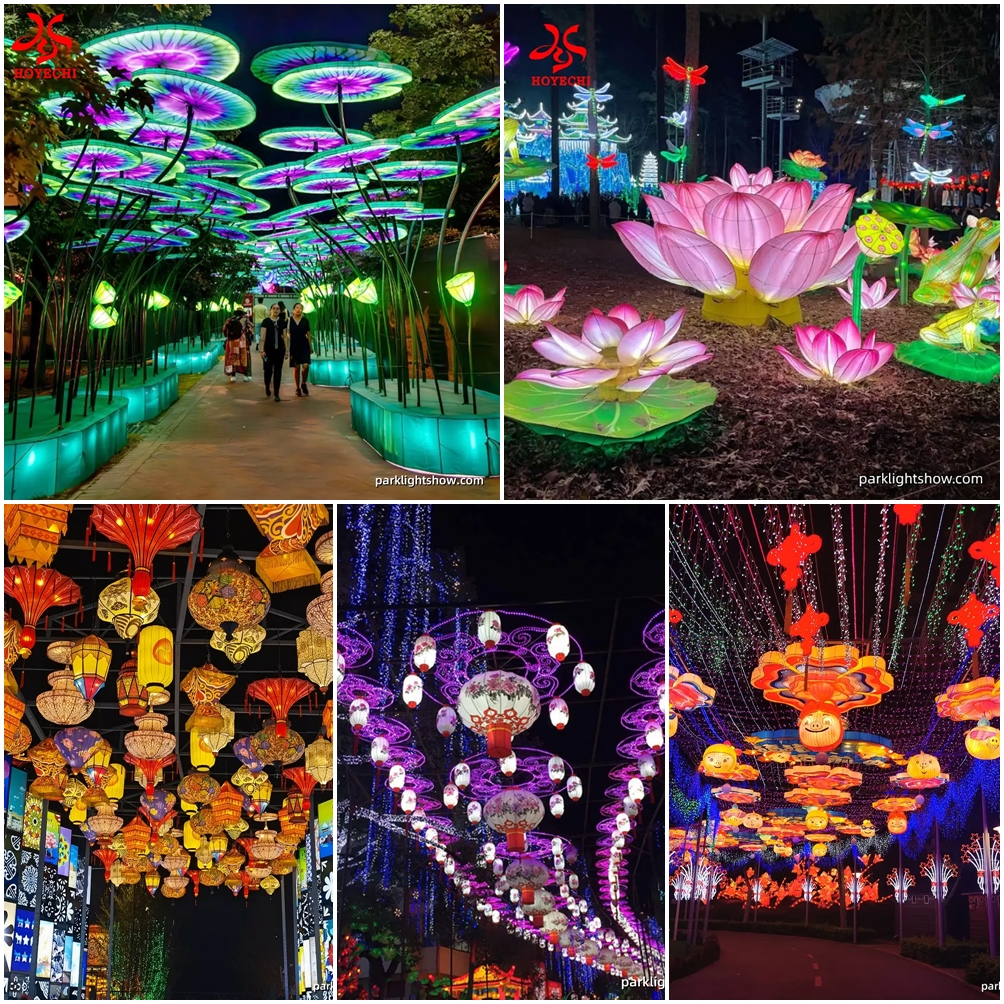Lanterns Meet Europe: Festival Light Installation Strategies for European Celebrations
When traditional Chinese lanterns encounter European festivals, the key to installation lies in blending cultural uniqueness with local festive aesthetics. For popular occasions such as Christmas, Carnival, and Midsummer in Europe, effective lantern integration requires thoughtful consideration of venue characteristics, cultural context, and safety standards—creating a harmony of light and tradition.
1. Christmas: Gentle Collision Between Lanterns and Holiday Warmth
Christmas is the most celebrated festival in Europe. Market squares, plazas, and church surroundings are core zones for lighting decoration. Lanterns must adapt to a warm and sacred atmosphere while maintaining cultural distinction.
- Theme Adaptation: Inspired by “Starlight and Shadows,” traditional lanterns can be reinterpreted as “Christmas Light Orbs.” Using woven frames wrapped in translucent paper printed with simplified holly leaves and bells, fitted with warm LEDs, they resemble glowing fruits. Replace dominant red tones with forest green and cream white to better align with European aesthetics.
- Installation Highlights:
- Christmas Markets: Hang medium-sized lanterns (30–50 cm diameter) along walkways at 2–3 meter intervals, alternating with pine-shaped or star LED strings. Maintain a 2.5 m height clearance and use jute sleeves to conceal wires while enhancing the rustic feel.
- Church Plazas: Use steel cables to suspend large lanterns (1–1.5 m diameter) radiating from church spires. Incorporate Gothic-style patterns to cast stained-glass-like projections on the ground. Prior permission must be obtained and religious sensitivities respected.
- Community Streets: Use magnetic mini lanterns on windows or doors. Lampshades can be personalized with family initials, blending festivity with individuality.
2. Carnival: Dynamic Integration with Street Celebrations
European carnivals, such as those in Venice or Cologne, are defined by exaggeration, interaction, and movement. Lantern installations should break static forms and adapt to parades and street performances.
- Theme Adaptation: Emphasize “Color Collision and Bold Shapes.” Create wearable lantern pieces and mobile structures. For Venice, design Baroque-style face mask lanterns (60 cm diameter) with translucent eye and lip sections lit by color LEDs that flicker with movement. For Cologne, decorate parade floats with rotating lantern clusters (beer mugs, windmills) driven by motors, creating dynamic light trails during motion.
- Installation Highlights:
- Parade Routes: Install motion-activated lanterns on building façades using waterproof PVC. Lighting wires can be hidden in drainpipes to maintain aesthetics and safety.
- Main Stages: Construct 3-meter-tall lantern arches using metal frames and hundreds of small lanterns. Ensure a 5-meter span for float access. Suspend a central 2-meter lantern that lowers during performance peaks, enhanced with fog for a “lantern rain” effect.
- Interactive Zones: Set up DIY lantern booths offering pre-cut frames and paints. Visitors can create personal lanterns and hang them on a temporary grid (1.8 meters high) to form a “thousand-lantern wall.”
3. Midsummer: Poetic Coexistence of Lanterns and Natural Light
Nordic Midsummer celebrations (Sweden, Finland) focus on nature and bonfires. Lanterns must embrace the white-night setting and work within long daylight and short dusk conditions.
- Theme Adaptation: Inspired by “Plants and Stars,” create translucent lanterns using thin wood strips shaped into ferns or forget-me-nots. Equip them with low-lumen LEDs to preserve the natural vibe. Cover with semi-transparent rice paper to mimic sunlight filtering through leaves.
- Installation Highlights:
- Festival Lawns: Mount lanterns on bamboo frames at eye level (1–1.5 meters), spaced 1.5–2 meters apart. Attach reflectors underneath to cast light silhouettes onto the grass at dusk. Avoid metal bases to minimize turf damage.
- Lake and Forest: Place floating lanterns on lakes using foam bases and sealed waterproof designs. Space them 5 meters apart in constellation patterns like Ursa Major. In forests, embed ground lanterns flush with soil, casting light upward to trace tree outlines without disturbing wildlife.
- Around Maypoles: Wrap ring-shaped lantern strings around Midsummer poles. Extend lighting cables upward, connecting to floral wreaths atop the pole, with warm yellow hues blending into the bonfire’s glow at dusk.
4. Universal Principles for European Installations
- Material Compliance: All lanterns must meet EU CE certification. Electrical wiring for outdoor use must comply with VDE (Germany), NF C15-100 (France), and similar standards. Wood or paper components should be pest-treated, especially for Nordic climates.
- Cultural Sensitivity: Avoid overly vivid or theatrical designs near churches or monasteries. In historic districts (e.g., Rome), use non-invasive fixtures like suction mounts or ropes—no drilling or adhesives.
- Climate Adaptation: In Nordic regions, use cold-resistant LED chips (-10°C to 5°C). In southern Europe, apply UV-protective coatings to prevent fading or cracking in strong sunlight.
Within the context of European festivals, lantern installations are not simply transplanted cultural symbols—they become luminous storytellers of shared joy. When Venice’s carnival masks dance with Chinese lanterns, or Sweden’s Midsummer grasslands glow under lantern shadows, these lights from the East transform into festive messengers that transcend geography.
Post time: Jul-31-2025





